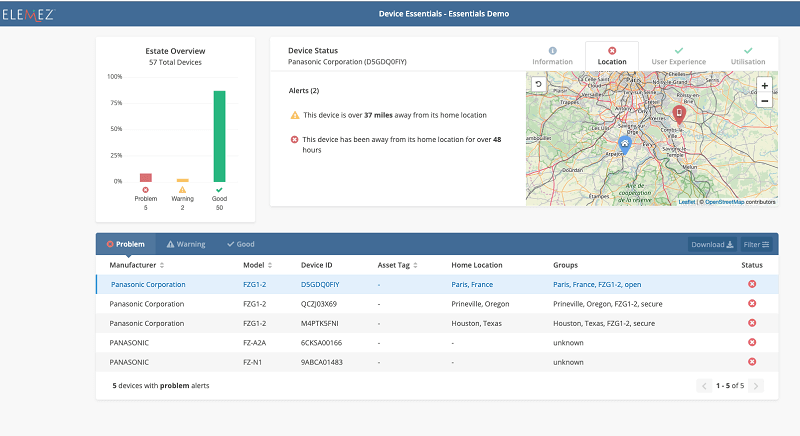Life’s too short for IoT devices ‘that move’ when they are not managed properly

The Internet of Things (IoT) has long been predicted to be one of the main drivers of revenue within the fourth industrial revolution across a range of different industries. And it’s easy, says Gary Lee, chief revenue officer, B2M Solutions, to see why IoT has become the go-to technology for efficient data management and utilisation through the mass connection of devices.
More and more businesses are pushing their finances behind revolutionary IoT initiatives to drive customer engagement, enhance business processes, streamline workflows and increase profit margins. However, before companies can adopt this revolutionary technology, they need to have the right enterprise mobility strategy in place.
Why? Because the “Things” in IoT includes mobile devices. They are connected things in the hands of virtually every worker these days, and companies of all shapes and sizes have some sort of existing mobility device strategy, with many even having an effective mobile deployment strategy and onboarding processes in place. Despite this, many still fail to manage these devices efficiently and cost-effectively, something which should be placed high on the agenda before deploying expensive tech such as IoT.

Bad mobile device management equals bad deployment efforts
The main issue that companies need to deal with as a first port of call before deploying IoT technology is to assess the business need, the return on investment (ROI) and whether they can accommodate the integration of the technology. At first it’s easy to assess the business need and the potential ROI of IoT, but with regards to the possible accommodation of its overall ‘Total Cost of Ownership’ (TCO), it then becomes a whole different ball game.
IoT enables you to connect millions of devices and transfer data between them over an extensive network without the need for significant human interference. For this to work efficiently, the health and locations of these devices need to be monitored properly. The problem is that a large portion of companies are simply not monitoring the ‘things that move’. This includes some of the most ubiquitous products that we use everyday, such as mobile devices or tablets, each of which can be an important component of IoT.
This lack of effective mobile device monitoring is exacerbating what is already a debilitating problem for many businesses. That problem is mobile device failure in the form of a software or battery malfunction. This is so serious a problem that it is costing companies an incredible amount of downtime resulting in wasted resources and lost productivity, all of which increase the TCO.
For companies that don’t understand this before embarking on expensive IoT initiatives, failure to address this problem will mean money wasted on poorly managed devices prone to failure, resulting in bad ROI and unattainable business goals. The bottom line here for many companies is the loss of revenue and bad ROI, and this will continue to get worse if the issue is not addressed before deploying IoT.
Effective device monitoring to make the most of IoT ROI

Gary Lee
Once the tech is deployed, though, the job is not done. It isn’t simply a case of ‘leaving it be’. The mobile devices that the tech runs on will still need to go through regular bug fixes, software updates, repairs and even replacement for those devices that completely fail.
Each and every time this occurs, there will be a certain drop in productivity and an increase in downtime. With IoT applications, many of which are mission-critical, this cannot be allowed to happen, so companies need to think ahead and minimise the chances of this happening to protect their revenue streams and customer base.
Proactive monitoring for the health and locations of these devices is one of the solutions in tackling what seems to be a common occurrence caused by a lack of proactivity from the company IT departments. This business-critical issue is very much a ‘hidden’ issue due to IT not often anticipating device failure or malfunction, and not being able to deal with the ensuing result due to a lack of the necessary tools to detect and deal with the issue proactively. This is not IT’s fault.
Essentially, IT needs the right tools in place to effectively monitor enterprise mobility devices in real-time – something which until recently was impossible. This means that they will be able to monitor the battery health and software updates of devices, and take immediate action by either changing the faulty battery or starting the software update before any device failure can take place.
This gives companies greater control over their mobility devices, helps them limit revenue loss as a result of badly managed devices and helps determine the right deployment strategy for IoT to gain the ROI that they seek. IoT is a revolutionary technology but will only work well with appropriately monitored and managed devices.
The author is Gary Lee, chief revenue officer, B2M Solutions.
Comment on this article below or via Twitter:
Recent Posts
- What Is an Exoskeleton Suit?
- Where can you use an ultrasonic motor?
- Smart Camera: System That You Can Use for a Wide Variety of Purposes
- Why Is the Smart Toothbrush Better Than a Regular One?
- Microcontrollers: An Integral Part of Embedded Hardware
- Air Quality Monitoring System: Why It’s So Important in Modern Realities

